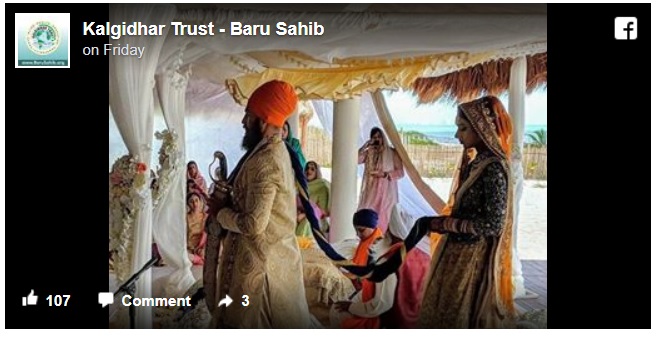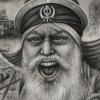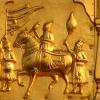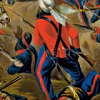Leaderboard
Popular Content
Showing content with the highest reputation on 07/28/2022 in all areas
-
Gen X fudoo blokes with all their cluelessness happen to be this way because of how they were brought up. We are not one mass of people, we all migrated out of Punjab at different stages and our circumstances and values dictate of our tempremant, personality and outlook. Gen X grew up at a time with mothers out of the 1960s who are a different breed compared to the ones who came in the 1990's. This generation was brought up with tinted glasses because you might have gone to Punjab for holidays and people were very different then and you did not see the mass migration of freshies. The parents of those Xers pushed a narrative of "Gora Bad! Indian Good!" It's not Gen Xers fault. Like I might have mentioned before we Punjabi Sikhs (like all the other subcontinent ethnic groups) always felt a sense of moral superiority over the gora. We have been brought up with delayed gratification whereas the new arrivals have instant gratification. Amongst other things we have seen the freshies indulge in, I think that moral superiority we might have felt has probably gone. The post 2005 freshie's were brought up with India Govt schenigans so it stands to reason they are clued up. We did not grow up there so we would we? Now we have reach the 2020s, the various Sikh communities probably walk in different directions. The only time maybe when an older established Sikh may interact with the freshie Sikh is when they need some buidling work done. Later generations of arrivals will not appreciate the sacrifices made by the earlier arrivals They are either indifferent or don't care. I cannot relate to them and they will not with us. They do not consider us as one of them. We may have the same roots and heritage but we are different types of people. They look at us and think "Why are these lot lecturing us on how things are done. I had my 2 phulke and know more than these dumba $$es" To any older generation Sikhs, lets not lecture the freshie's. Let them get on with their puttheh kam and let us get on with our own business.2 points
-
If I'm entirely honest, I don't see what's wrong with it. Aside from the whole "don't modify your body" thing, but I don't know how much weight that argument holds. My mum told me that back in the day it wasn't uncommon to see pagg vaale with earrings. Then again, doesn't mean if you wear a pagg you're religious. But now we seem to have more and more sources which point to Singhs having earrings, and it doesn't seem like it was a big deal.2 points
-
They are taking away our universities too now. Did you check that news about Punjab and Sindh bank. I didnt even know it was started by Sikhs. They are taking away all our institutions slowly. They are evil.1 point
-
1 point
-
1 point
-
You make a great point. I remember when I was a kid. You'd see a clean shaven Sikh uncle, and almost without exception, his wife would still have uncut hair tied in a bun. Almost all the "uncles" in our social circle were monay, but I really cannot recall every seeing an "auntie" type with a haircut. (Perhaps the situation was different in the UK where, by the 80s and 90s, there were already "auntie" types who were born in (or grew up in) the UK and maybe they had haircuts.) In Punjab, certainly, the hair cutting trend among Sikh men started long, long before it picked up among Sikh women. It's shocking just how quickly it has somehow become more prevalent among Sikh women. I blame Sikh parents who take a sexist attitude and focus on their sons and their Sikhi while looking the other way when it comes to their daughters.1 point
-
Good points. It's just annoying when people go on an anti-jewellery crusade, often times quoting Gurbani way the hell out of context or quoting Dhan Sant Singh Baba Ji Dharmicwale to justify their bulltutti. It's like wanna wear it wear it, don't wanna then don't, otherwise stfu. This black and white malarkey does so much damage.1 point
-
The paintings speak volumes. It's clear it was normal for the women to wear jewellery in those days. Some men had earrings but in this day and age will just look camp on a Singh ?1 point
-
The kattar view against jewellery and oranaments for both men and women when made so black and white, is ridiculous. There is either weak foundations for it or none at all.1 point
-
I'm not convinced it's a keski. My grandmother used to wear a head ornament that used to be placed under the chunni, the name escapes me now but will try and find out what it was called, something like this, but they came in different sizes, may explain the protrusions depicted. *edit - its called a sagi phul The other thing you'll find in older paintings is the jewellery adorned by the women, something which is frowned up by certain quarters. I personally have no love for gold or shiny things and luckily neither does the Mrs, but it is of interest to see how the image expectations of women in stricter circles has developed over time.1 point
-
Have you considered that maybe on this one special day, he didn't want to "bike" to his wedding? I thought people were criticizing him for marrying a non-Amritdhari. That is warranted. To begrudge him not having a super-simple wedding is not warranted. I suppose you're also upset that he and his bride wore finery on this one special day instead of khaddar (homespun cotton)? If they wanted to wear khaddar, that's fine, too, but they didn't, and that's fine, too. Compared to what some brides wear, her clothes are extremely conservative: no cleavage, no bare midriff, no arms even. What's the problem? What you're saying would have some import in context. The fact is whenever there's a wedding among our people, rows upon rows of airplanes are filled with people flying out (or in). If that were not the case, then your complaining about Jagmeet Singh's airplane ride would have an impact, but it doesn't. Huh? Then on what basis? Are you serious? What are you even talking about? Did you not see the pictures @jkvlondon posted here? Just so there's no misunderstanding, here's the actual wedding pic (attached). I ask you again: She's wearing a chunni (on her head, not around her as a fashion accessory on her shoulders). What else do you want?1 point
-
Guys secretly admire girls with open hair. My husband always used to encourage me to leave mine open. Uncut hair is hard to leave open without it blowing everywhere and getting untidy. I finally told him - they cut their hair to get that look. So yes- being amritdhari does mean that you have rid your feelings for a spouse whose looks match the western ideal stamped upon us by advert after advert about what looks best. Why don't people see it as a positive - as in a cut hair girl actually married a sikh boy When they reject pag vale we complain - do wheres the praise now? An apna married an apna and we are still sad. What do we want and who made us judges by the way?1 point
-
1 point
-
Are u sure it was only the farmers tho? There have been prominent khatri sikhs in the indian army such as aurora. Im sure it was a family tradition to join the army for them1 point
-
A - Actually several of the 52 Hukams are gender specific - Par istree, ma bhain, dhee bhain, kar jaananee. Par istree da sang nahee karnaa| Istree da mooh nahee phitkaarnaa| Singhaa da adhaa naam nahee bulaunaa Guru Sahib is clearly only addressing Singhs here. It wouldn't be a great intellectual leap therefore to assume that Dastaar binaa nahee rehnaa| may also have been specific to men. It's also very likely that Guru Sahib didn't state that the dastaar is only mandatory for men because this was common knowledge at the time. B - If you're going to use the Nihangs as the historic benchmark for the Sikh rehat, then you should accept jhatka/mahaprashad and sukha as authentic precepts of the rehat as well. But you won't, will you? You can't use the Nihangs when something about them suits your agenda, and then discard them when it doesn't. You can't pick and choose like that. Their rehat is their own, not that of the entire Sikh world. C - That's exactly what I'm saying. Some women wear a dastaar, most don't, and good luck to all of them. The Taksaal however has never made it mandatory for the wives of its members (remember that there technically aren't any woman in the Taksaal, it's male-only) to wear a dastaar and that is the distinction. Do I really have to say it again?... I'll try it one last time - The only point I am making is that dastaars were never mandatory for Sikh women. I'm astonished that so few of you seem capable of digesting such a simple idea. These same historical accounts are also the ones which specify that Mai Bhago dressed 'like a man'. If wearing a dastaar was to dress like a man, then it very strongly implies that it wasn't seen on women very often.1 point
-
Lol. Our Guru tells us to pursue truth in all things. This includes our itihaas, no matter how inconvenient the truths of our history may be to our own personal agendas. Some of you still don't seem to understand the point I am making. I never said that no Sikh woman ever wore a dastaar, I never said that it's inappropriate for a bibi to wear a dastaar. My point is that the situation now, where most bibiaan do not wear a dastaar, is not unlike how it has been throughout our history. The AKJ Rehat is the one that was fabricated by British influenced Sikhs, playing pick and mix with the Nihang Rehat by taking bits they liked (keski, sarbloh bibek) and abhorring those elements which were in conflict with their revisionist policies (jhatka, raagmala/raag kirtan). The Nihangs may have been around since Puraatan times, but so has the Damdami Taksaal. Why do they not require their women to wear keskis? I refuse to believe that a group founded in the 20th century is better placed to access the truths of our history than one which came into existence with the physical blessing of Dashmesh Pitaa himself. It is also worth mentioning that not even the Nihang Singhs make the assertion that the dastaar is mandatory for all Sikh women. No puraatan, historic samparda does.1 point
-
It is completely possible to get a high top-knot without the support of a nihang-style bunga. Many Jatt women also wore their hair in this fashion: https://en.wikipedia.org/wiki/Jat_people#/media/File:JatGirlAllyghur1868.jpg Mai Bhago was said to have adopted 'the dress of a man' during the Battle of Muktsar and worn it thereafter when she became one of Guru Gobind Singh's personal bodyguards. If it was commonplace for Sikh women to wear dastaars as well, this remark would not have been made. Nor would later European commentators have drawn attention to the fact that female Nihangs distinguished themselves from the majority of Sikh womanhood by wearing turbans.1 point
-
Those are precisely the sorts of images I am talking about. Those aren't keskis, they are very large topknots towards the back of the head. When Sardar Baghel Singh marched into Delhi, the Mughal Shah Alam II came out to welcome him with his begams. A group of ten Singhniaan were invited to the begam's quarters, where these Sikh women fascinated the Shah's wives and courtesans with their talk of warfare, plunder and how to shoot missile weapons. Five of them were dressed like Nihang Singhs, the others wore dresses, heavy ornaments, heavy lower garments and top knots a hand-span-and-a-half in height. This description exactly fits those images you have provided. I find it strange that Bhai Manvir Singh resorts to those images in order to further his mistaken beliefs, especially since the woman on the left is clearly shown to be wearing many sets of golden bangles (Bhai Manvir Singh and most AKJ oppose the wearing of jewellry).1 point
-
Nobody is casting aspersions on the sincerity of these Bibiaans' faith. But there is no historical basis for your claim that the keski/dastaar was enjoined upon all Sikh women in the old days.The situation today is how it has always been - some women choose to wear a dastaar, but most don't. Do you have any sources corroborating your other claim about Gurmukh Singh Musafir? None of the portrayals and accounts of the Sikhs before the 1920s represent Sikh women as mostly wearing turbans, the notable exceptions being female members of the Nihang order (and Mai Bhago, who was conspicuous by her manner of dress). The most common way in which bibiaan wore their kes was in a high top-knot towards the back of their heads, beneath a chunni. These gorified folks you allude to are also precisely the people (Lahore Singh Sabha) whose movement helped give rise to groups like Bhai Randhir Singh's.1 point
-
Read what I posted before you get emotional. Not once did I allude to it being a fashion statement. I suggested they felt compelled to adhere to this aspect of their faith due to the growing intolerance and hostility from an increasingly prejudiced western society, in affect thumbing their nose at bigots who want religious people to assimilate and disregard all overt, external articles of faith under the pretence of societal harmony.1 point
-
I'm merely referring to modern times, particularly in the West in recent years. I grew up around Gursikhs as a child, but even back then, I don't recall many of the bibiya - of all ages - wearing a dastaar. Although when I went to India as a child, I saw many Gursikh females wearing a turban. I'm aware it has historical precedent. Just trying to understand the sociological reasons for recent trends, particularly since 9/11 has put religious beliefs under the microscope.1 point
-
I have not read anywhere whereby Guruji Maharaj specifically asked for women to not rid themselves of facial hair. Nowhere is it written. In my humble opinion, I very much doubt Guruji Maharaj would want Sikh women to look 'butch' and like men. The requirement for keeping a beard is aimed at men and not women. Otherwise why didn't Guruji ask for womens head when he created the 1st Panj Pyare? Or at least a mix of men and women? If the requirement for men and women are identical, then surely he would have called for womens head as well. Obviously women back in the day could not wield a sword or fight in battle like men so men were chosen. Since Guruji saw the difference between the 2 genders therefore it is only logical that the requirement for the 5K's for women are not identical to men. With any kind of organization be it religious or social in it's infancy there will be pragmatism. Pragmatism is when one is able to see thing in a balanced manner. In time, dogmatism takes over and rules are applied in a dogmatic way. People who are pragmatic are able to think in multi dimensions whereas dogmatic people think in single dimensions. Lets take the US constitution as an example. The US constitution states the US citizenry has the 'right to bare arms'. This was incorporated into the constitution in order ensure that the citizenry were well armed in case the government became tyrannical. Also back in the day, you were on your own in some distant farmland and times were dangerous. You needed guns to protect yourself. Those who are dogmatic today will say 'I should be able to have any kind of weapon as the constitution said I have the right to bare arms'. 'Thats what the founding fathers said and thats that'. Should the average civilian be allowed to own a bazooka? How about rocket grenade launchers? Drones? Heat seeking missiles? Obviously some sort of pragmatism is needed here. As for the argument that hair is natural and should be left uncut, that is pure nonsense. We are not born with a rule book in our hands stating what is natural and what isn't. If it is so unnatural to cut hair, Waheguru Ji would have made cutting hair painful or resulting in death. This argument is pure nonsense. As for the OP stating Gillette has brainwashed the masses, she is obviously quite ignorant to history of mankind and has never heard of 'threading'. As soon as humans found a way to cut their hair, they did it. You can see this in all cultures and has existed hundreds of years. Men and women are naturally attracted to beauty and there is nothing wrong in that nor is it 'shallow'. It is only shallow when that is the ONLY basis when looking for a partner. Those who are arguing that it is 'shallow' or 'unnatural' have a twisted view of reality. From a psychological standpoint I believe we humans 'need' beauty. That is why we wax/ polish our cars, paint our houses, cut the lawn, iron our clothes...etc, etc. Without beauty, life becomes depressing. These are just my humble thoughts. Thanks.1 point
-
I'm sure there are some people who are not attracted by physical appearance and only to the soul but they are rare. Viaguru made us into physical beings and to be physically attracted to someone is not wrong or dirty as that is how Vaiguru made us, just as we have a desire to eat. If it is only about attraction of souls than why the need for different genders with different physical forms. Attraction is more than just liking someone's physical appearance, as 2 people may find different people attractive but it is an aspect of connecting to another person, I don't see anything wrong with that. If you are looking for a marriage partner especially in our culture you won't always have time to get to know their soul in depth before marriage. There's nothing shallow about it.1 point
-
Think you are going OTT about this. Yes whT mai bhago did was brave but only when women act in ways that are typically celebrated as male are they celebrated in sikhi. What about bebe nanaki the first to recognise guru Nanak ji but she is not widely celebrated. Is there evidence of women keeping facial hair in the times of the gurus? In order to make children there has gone some level of physical attraction & unfortunately I don't think many men will find facial hair attractive in women. Please stop the political correctness and be honest1 point
-
Why lie to ourselves? Why? Why not just admit the plain, harsh truth that as a man we women to look feminine and not 'manly' with facial hair? I've seen this same type of lies given ie 'she's not my type', 'I prefer shorter/taller women', 'she's not into poetry'....etc, etc when in truth the men are rejecting simply because they are not beautiful and those with facial hair look like men. BTW 'getting to know the person, dating and finding similar hobbies...etc, etc' are western concepts. They never or rarely existed in Punjabi culture. Both my grandparents didn't meet their future wives until the wedding day (so I've been told). I heard this was pretty much the norm back in the day. If you are truly 100% beyond looks you will marry whomever your parents choose for you and on the spot you will agree. This 'getting to know the person better, dating....are just lies. There maybe 'some' truth to it but it's mostly used as a reason to reject. I admit it. I admit, some looks are important to me. Yes, I'm weak and not strong but at least I admit the truth about myself. I guarantee you, majority of these people advocating allowing facial hair to grow, will never marry a woman who has a slight beard. Prove me wrong Mr. Singh. The OP is looking for a bachelor. Might I suggest you give her your biodata?1 point
-
sometimes feel women in sikhi are either invisible or there is pressure to take on a male identity, men and women are different there's nothing wrong in looking different, why must there be pressure to look the same. Like someone else mentioned I've never seen a picture showing women having facial hair in the Guru's times. Does anyone know of any accounts/evidence that women did keep facial/body hair in their times. Its ok for men to say keep your facial hair, for men it can be seen as a sign of masculinity. We need to value women and there qualities and not pressurising them to keep hair on the face so they look male. There's a lot of focus on male identity in sikhi - battles, weapons, warriors, but we also need to celebrate the softer female side too. Most men do not want a wife with facial hair - that is the truth, why should the poster not have the chance to get married and have a family. Women have a limited time to have children and who knows how long it will take to find a man who doesn't mind a wife with facial hair.1 point
-
In short, you won't. Lets stop kidding ourselves. Those other check boxes are just excuses to decline an alliance.1 point
-
Curious, would you marry a woman with a beard? Or an almost visible mustache? The OP sounds like someone who had been brought up with a very strict code of conduct and those who preached would practice. But she's learning the hard way that many 'talk the talk but don't walk the walk'.1 point
-
Just answer the question, would you marry her? Be truthful and stop deflecting. We all know the answer already. Let's play your game. Why are you cutting your nails then? Let it grow out then. Why take a shower or clean yourself after taking a dump? It's all part of our body right? See how easy that was? In my opinion kesh IS for identity. This prevented many practicing Hindus to swallow Sikhism and make it a sect of Hinduism. By creating the requirement for keeping long hair and turban, it effectively prevented 'fence sitters' to dictate and claim Sikhism is a sect of Hinduism. It once and for all forces you to choose. There is no grey area. Nobody back then had long hair with turban. Turban maybe but thats it. The truth is you can argue pretty much anything if you want to argue. But the truth is based on facts and not opinion We all have an opinion on everything. You believe any facial hair removal is bad and others think differently and it's their perogative. Thats fine and dandy however that is your opinion, nothing more. Blindly believing in something based on someones personal opinion is basically creating a set of dogmas. No need to reply. Thanks.1 point
-
I also find your post extremely 'offensive' thus will not dignify with a response as well. :stupidme:1 point
-
If I'm not mistaken they are mentioned in Sakhias. Do you also believe a woman donning a full beard and turban like a man is ridiculous? Be brutally honest, would you marry a woman with a beard?1 point
-
1 point
-
@Barfi Would you marry this woman? http://vitaminw.co/culture-society/sikh-woman-grows-beard-and-gets-touch-her-feminity1 point
-
@Barfi Thanks for the long write up about hair. I assure you I know what hair is. Sorry but you're wrong about women not having beard like hair on their face. I've seen it myself. In fact there is a popular story about a Sikh woman who has a full beard in the UK that is traversing the net. Have you not read that one? I'll try to find it for you. I've read a couple of books on Sikhism and nowhere does it state that Guruji Maharaj specifically state women must keep their facial hair. I believe the requirement for keeping a turban, beard...etc, etc is for creating a Sikh identity and eradication of inequality, nothing more. The notion that long hair gives one strength, health...etc, etc are add on's made by Sikhs to bolster support for keeping beard and hair. You would frequently hear Sikhs quoting Samson and now lately Jesus, Moses...on supposed good effects of keeping long hair. The irony of it all is that the keeping of long hair actually makes you bald faster then short hair as evidenced by those who cut their hair to become 'mone'. I'm willing to wager that the majority of posters here supporting women keeping their facial hair would never get married to a woman with a 'mini beard'. Lets be honest and not lie to ourselves. I could be wrong and ask for apology in advance but I very much doubt Guruji Maharaj would want Sikh women to look like men.1 point
-
Nope, not stopping. What you gonna do about it? Why don't you get lost?1 point
-
In my limited understanding of Khalsa order the keeping of beard ie no facial hair only applied to men and not women. "Why would Guru Sahib specify that women must not "remove facial hair"? " Simple because generally women do not have beards however it does happen.1 point
-
Nope. I'm asking when did Guruji Maharaj specifically state women must not get rid of any facial hair.1 point
-
1 point
-
To the OP @Sikh Woman May I humbly ask, did Guruji Maharaj specifically request that women also must keep their facial hair? To the best of my knowledge the requirement is only for men.1 point
-
WJKK WJKF I have seen so many Bibia with facial hair and full beards who are now married to singhs. They eventually were able to find a husband. What I feels it that sometimes it just circumstances that lead to people not being able to find a Singh/singhni. If you think that only amritdhari bibia have trouble finding a husband than you are sadly mistaken. I have had my fair share of experience that you would not believe. Seriously amritdhari bibia can be pick too. The kind of responses that I got were totally unbelieveable. It goes both ways. Sorry that you are having trouble finding somone but I think you should ask sangat to help you. All the bibia think that we Amritdhari Singhs want a moni but that is totally untrue and blatantly false. We could care less about your facial hair heck we want someone who keeps all her hair not just the kesh on the head. I have tremendous respect for the bibia who keep all the kesh not just the Kesh on the head. I think there is a matriomonial servies in UK goes from GW to GW to help out so check them out maybe they can help. Sorry about the rant just had to say it because I am tired of hear this that singhs won't accept bibia with kesh.1 point
-
Sikh boys have not been bought up in the culture that if they wear a turban and keep their own hair that they should marry a girl who keeps her bodily hair too. Sad but true thing if our time. Sikh boys are hypocritical.1 point
-
Gurfateh ! The Royal Houses of Punjab with their rich history and Lavish lifestyles have have always fascinated me.The Five Sikh Houses of Patiala, Jind, Nabha, Kapurthala and Faridkot along with the Muslim state of Malerkotla all carry the Blessings of the Guru Sahiban. The Phulkian states of Patiala, Jind, and Nabha all descend from Phul of the Brar Bans, born AD 1627 .After the Battle of Gurusar (AD1631), Phul came to Guru Hargobind Sahib with his brother Sandaali and his 'chacha' , Uncle, Kala. In the diwan of Guru Sahib, Phul began to beat his belly to indicate he was hungry. Guru Hargobind Sahib gave Phul the blessing that Guru Nanak would bless Phul with the capacity to feed thousands and he would one day have a kingdom. Guru Har Rai Sahib also blessed Phul on his travels in Malva (AD 1646) The sons of Phul - Tilokh Singh and Ram Singh were blessed with Khande di Amrit from Guru Gobind Singh at Damdama Sahib - They were blessed with the 'Apaar kirpa' of Guru Gobind Singh - evidence of this can be seen in the Patiala Hukumnama sent by Guru Sahib in 1696 Text of the Hukumnama ; ੴ ਸਤਿਗੁਰੂ ਜੀ । ਸ੍ਰੀ ਗੁਰੂ ਜੀਉ ਕੀ ਆਗਿਆ ਹੈ ਭਾਈ ਤੇਲੋਕਾ ਭਾਈ ਰਾਮਾ ਸਰਬਤ ਸੰਗਤ ਗੁਰੂ ਰਖੈਗਾ ਤੁਧ ਜਮੀਅਤ ਲੈਕੇ ਅਸਾਡੇ ਹਜੂਰ ਆਵਣਾ ਮੇਰੀ ਤੇਰੇ ਉਪਰਿ ਬਹੁਤ ਖੁਸੀ ਹੈ ਤੇਰਾ ਘਰੁ ਮੇਰਾ ਹੈ ਤੁਥੁ ਹੁਕਮੁ ਦੇਖਦਿਆ ਹੀ ਛੇਤੀ ਅਸਾਡੇ ਹਜੂਰ ਆਵਣਾ ਤੇਰਾ ਘਰੁ ਮੇਰਾ ਅਸੈ¹ ਤੁਧੁ ਸਿਤਾਬੀ ਹੁਕਮ ਦੇਖਦਿਆ ਹੀ ਆਵਣਾ ਤੁਸਾਂ ਅਸਵਾਰ ਲੈਕੇ ਆਵਣਾ ਜਰੂਰ ਆਵਣਾ ਤੇਰੇ ਉਤੈ ਅਸਾਡੀ ਭਾਰੀ ਮਿਹਰਵਾਨਗੀ ਅਸੈ ਤੈ ਆਵਣਾ ਇਕ ਜੋੜਾ ਭੇਜਾ ਹੈ ਰਖਾਵਣਾ ਭਾਦੋਂ ੨. ਸੰਮਤ ੫੩।” (੧੭੫੩) Translation (from the 2003 Dix Noonan Webb sale catalogue for the Sale of the 'Nishan-i-Phul') There is one God. The Guru is great. It is the order of the Guru. Bhai Rama and Bhai Tilokha, the Guru will protect all. You are required to come with your contingent. I am much pleased with you. Your house is my refuge. On seeing this letter you should come in my presence. Your house is my refuge. You should come to me immediately. On seeing this letter you should arrive with horsemen. Do come. I have sent one robe of honour. Keep it with you. Written order, hukamnama, from Guru Gobind Singh to the brothers Rama and Tilokha, dated 2 August 1696. In the Hukumnama the brothers are asked to come to Anandpur with Soldiers, arms and horses ( as all Sikhs were ordered to ) to help Guru Sahib in his Battles with the Hill Rajas - Guru Sahib states that "Your house is my refuge" - 'Tera Ghar Mera Asey' - This has become the Patiala motto - seen on the 'order of Phul' and other medals and decorations. It is said that it is because of this blessing from Guru Sahib that the 11 Missals never attacked the Phulkian States despite some 'dubious' behaviour on their part. Ram Singh went on to form the House of Patiala and Tilokh Singh the Houses of Nabha and Jind. These Houses are from the Brar Bans , Patiala being Sidhu-Brars, the house of Faridkot is also Brar - In the Zafar Nama Guru Gobind Singh states to Aurangzeb that " ਹਮਹ ਕ਼ੌਮ ਬੈਰਾੜ ਹੁਕਮੇ ਮਰਾਸ੍ਤ " - 'The Brars are with me and are under my command' - evidence of the special blessing of Guru Gobind Singh. The House of Kapurthala descends from Sardar Jassa Singh Ahluwalia born AD 1718 - the Sardar of the Ahluwalia Missal - leader of the Dal Khalsa. He was brought up by and received the "Ashirwaad" - Blessing, of Mata Sundari Ji (Wife of Guru Gobind Singh ji) in Delhi. On his return to Punjab he received a 'Gurj' - Mace , sword, a shield, a bow and a quiver full of arrows, a dress and a silver staff from Mata Ji - predicting that he would rise to eminence. Jassa Singh Alhuwalia succeeded Nawab Kapoor Singh - who had adopted him as a son and taught him Shastar vidia - Kapoor Singh gave him the sword of Guru Gobind Singh Ji - now kept in the Kapurthala treasury. Jassa Singh was well respected by all - it is he who blessed the Maharaja of Patiala - Amar Singh with Khande di Amrit. Jassa Singh had no heir and was succeded by Bhag Singh his cousin. The House of Faridkot was founded by Bhallan - who had helped Guru Hargobind Sahib at the battle of Mehraj. His descendent Kapura declined to help Guru Gobind Singh by not allowing the use of his fort at KotKapura - because he feared angering the Mughals - however he did help in a covert fashion at the battle of Muktsar in 1705. The House of Malerkotla - is a Pathan Muslim state - The Nawab of Malerkotla,Sher Mohammed Khan, was present when the Cchote Sahibzadas were sentenced to death by his relative Wazir Khan in Sirhind - he lodged his protest saying it was against the tenets of Islam and walked out of the Durbar in protest. When Guru Gobind Singh Ji came to hear of this, he blessed the nawab with a hukumnama and a sword . It is because of this blessing that Malerkotla saw no sectarian violence during Partition in 1947 and still remains a predominately muslim area in East Punjab. Here is a collection of Photographs - some of my favourite images - that document the Lavish Lifestyle of the Maharajas of Punjab. They are beautiful images captured by some of the worlds finest photographers. I'll start with the Blessings of the Guru Sahiban Phul at the Durbar of Guru Hargobind Sahib - beats his belly and receives a bountiful Blessing - which took the form of the Phulkian Kingdoms The Patiala Hukumnama The Nisan of Guru Gobind Singh Ji Details The 'Patiala Motto' the words of Guru Sahib - "Your house is my refuge" - 'Tera Ghar Mera Asey' The 'Nishan-i-Phul' or Order of Phul - with the 'Patiala motto'1 point
-
It depends how you look at it. Mostly throughout our history the majority of sikh women have not worn dastaars. I took sometime to discuss with the Jathedar of Hazoor Sahib. He told me that Mai Bhaag Kaur was the first sikh women to wear a turban, but she did so only for battle and after that she took it off and went back to her regular clothes. He noted after that point that sikh women started to wear turbans and it was usually only those who stayed in Nihang Dals and not mainstream sikh women (but they usually kept there heads covered). Then the AKJ heavily promoted it, Yogi Bhajan, Baru Sahib, etc, etc. and from there they started there "own" panth. The Jathedar was clear that Guru jee didn't give this Bana to women. So that is why you see it the way it is, it was never the majority of Sikh women, it was always a minority who belonged to some kind of jatha or dal or organisation, etc, etc. The mainstream women (even though they were amridhari) did not wear them. I think each group who is promoting this as "maryada", has there own history to support it and they are very clear on that. Mostly the whole equality theme is blown out of proportion. Man and Women can't be equal on a physical/mental/emotional level, it is impossible - we are basically like ying and yang and when they come together there is a balance. God has made us different on every level. Each sex is superior and inferior in its own way. Which then leads to a question of spirituality as to whether we can be equal on that level since so many other things are different? Mostly you will see samprada's don't support the wearing of women turbans. Although Nihangs and taksal don't have a problem with it, they don't propogate it either. The above is what I understood from the Jathedar Gagri Singh Baba Hardyal Singh.1 point
-
Brother, if she is from a Sikh background and you think your love for each other is strong enough, be caring, be sensitive, be strong. She is one of our own, even if she has cut her hair. In this day and age it is easy for any of us to lose our way. Take this how you want. Don't be another that fragments and discriminates in such a small community that is under attack from all angles. Teach her and learn from her. Kwaar hoye sab milangey Just watch your heart in all this.1 point
-
good post by singhavelli... personally, seen that in today's age, arranged marriages don't really work out...people simply don't have the same values that they once did...hence it's important for a guy and a girl to find out what their values are, if they are in common, and if they will be able to help each other on their respective paths...1 point
-
You are wrong about marrying within kin amongst Jat aristocracy. For reasons of their tribal origins, ie one got of Jats are reputed to be descended from one ancestor. A got like Dhillon say that they are descendents of one person so all Dhillons are related even thoug it is many centuries ago. In the old days a Jats didn't marry their kids even into the same gots as father, mother and both sets of grandparents. Only recently has the maternal got to some extent been disregarded.1 point
-
"They had two daughters and they married their daughters to their cousins (Maasi se mundian naal). " I heard many sikh groups from pakistan do this, because they lived according to Muslim culture up in Multan, sialkot etc Pre-1947.... My friends say that Lubhanas also marry their cousins...anyways sikhs don't really view these things as caste in the hindu sense because its not like aroras don't eat with non-aroras etc, it is all a class and occupation thing...like someone pointed out that aroras marry off their kids to their cousins, well that's why jatts say don't marry aroras cause they marry their cousins...anyways that is what i ahve noticed.... and of course there is no caste in sikhi...howvere their are certain sikhs that behave differently than other groups of sikhs, kind of like how "bibeki" sikhs don't eat with non-amritdharis.1 point
-
Waheguru Ji Ka Khalsa Waheguru Ji Ki Fateh I think Arora is just like another cast. In our pind in Punjab, the Bhais (Granthi and his family) were Aroras who lived in the Gurdwara and do Path and also had a dukaan (grocery shop), like other villages in Punjab. They had two daughters and they married their daughters to their cousins (Maasi se mundian naal). Muslims do that, but they were Sikhs and Amritdharis. It was strange. That's the only thing I know about them, maybe that was only one family that did this.1 point













